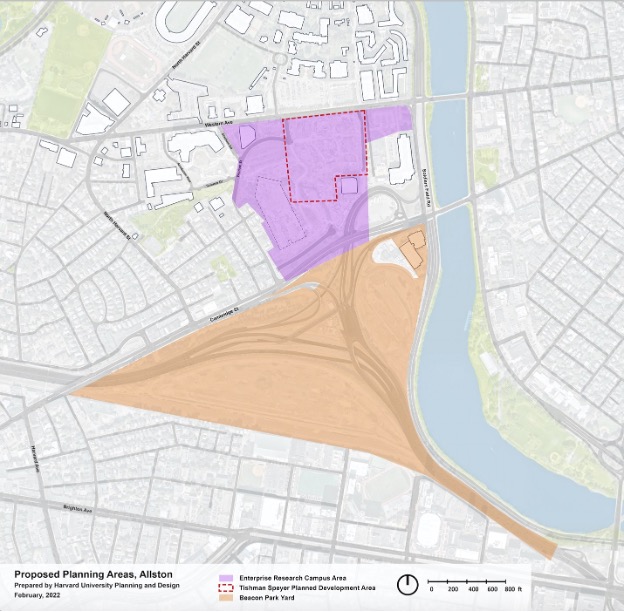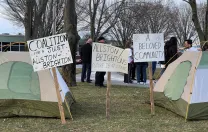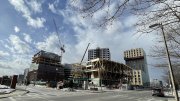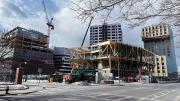
February 23, 2022
Dear Mayor Wu, Councilor Breadon, Representative Moran, Representative Honan, and Harvard Allston Task Force Members,
In his letter to the Harvard Allston Task Force on December 6th, President Bacow reinforced Harvard’s intention to create and contribute to a district in Allston that the University, and our neighbors and the City of Boston can share and be proud of. A necessary element of this work is collaboration with the City, local elected officials, and the Allston-Brighton community to respond to the important issues which have been raised in the last several months and throughout the public and community feedback process. We are grateful for this partnership and engagement and write to codify the efforts and commitments the university will undertake to advance this shared vision.
The following commitments have been informed by the extensive public review process related to the Enterprise Research Campus (ERC) Phase A plan, and Harvard’s broader ERC Framework Plan, which has included more than ten public meetings, and over a dozen pop-up events, site walks, surveys, and focus groups. Harvard and Tishman Speyer worked with the Task Force to broaden and expand community engagement efforts, and this has garnered more than 250 survey responses and expanded inperson engagement with community members in over a dozen venues. Some elements of this expanded community engagement remain ongoing, and we look forward to sharing the results with the Harvard Allston Task Force at a public meeting.
Further, we acknowledge the community’s expressed desire to expand planning discussions beyond the boundaries of the Tishman Speyer Planned Development Area to the larger ERC district. The ERC Framework Plan was designed to serve that purpose, and we look forward to taking that planning framework into the next stage of the planning process. We also envision a planning process for future development in Beacon Park Yard, in coordination with the Massachusetts Department of Transportation’s planning and schedule for the Allston I-90 Multimodal Project.
Harvard’s long-term goal for the ERC and Beacon Park Yard is to transform these obsolete and largely impermeable industrial properties into new, vibrant, equitable and welcoming districts that will complement and enrich the Allston-Brighton community. Centered around a multimodal transit hub, the BPY area will serve as a western gateway into the City of Boston while also becoming a destination in its own right, by fostering a life sciences and innovation cluster with unparalleled regional connectivity.
This letter summarizes Harvard’s public commitments[1] to further that long-term goal with respect to (i) a planning process for those portions of the ERC outside of the bounds of the Tishman Speyer Planned Development Area and, consistent with the timing and scope of the I-90 Multimodal Project, for Beacon Park Yard; (ii) open space, sustainability/resiliency in the ERC and Beacon Park Yard; (iii) affordable housing in the ERC and Beacon Park Yard; (iv) workforce development opportunities for Allston residents for jobs in the fields such as life sciences, technology; and, (v) mobility and transportation enhancements in the ERC and Beacon Park Yard.
Harvard anticipates that it will continue to rely on commercial real estate developers for future development in these areas and, as was the case for our selection of Tishman Speyer for its Phase A and B ERC proposals, will use the RFP process to ensure that third-party developers conform with our commitments to the community. In doing so, Harvard will directly advance the planning and public engagement for future projects in conjunction with involved developers to ensure efficient and effective methods of communication and accountability.
Planning and Community Engagement
The Harvard Allston Task Force has requested a community visioning process and a community needs assessment that would set a higher standard for university-community relations.
To this end, Harvard will:
• Fund and participate in an Allston-Brighton Community Needs Assessment, administered by an independent entity, and directed by the City of Boston, to help inform future Harvard community benefit priority areas.
• For the Enterprise Research Campus area, north of Cambridge Street, Harvard will participate in a City-led planning and re-zoning process to guide future development phases of the ERC outside of the Tishman Speyer Planned Development Area, informed by community engagement and input. We anticipate further discussions with City staff will determine the timing, scope, and entitlement mechanisms for this planning process for the ERC area.
• For the Beacon Park Yard area, south of Cambridge Street, Harvard proposes an additional complementary planning process with the City of Boston in conjunction with the advancement of the I-90 Multimodal Project to achieve an urban vision and a transformational framework for development of Beacon Park Yard, and its commensurate community benefits.
Open Space and Sustainability/Resiliency
We share a commitment to an open space planning process that focuses on climate adaptation, health, and equity. This commitment is reflected in Harvard’s longstanding stewardship of the Arnold Arboretum and its publicly accessible open spaces in Allston. The ERC represents a unique opportunity to organize new development around an inclusive network of open space that shapes a desirable, livable, sustainable, and resilient district that focuses on the public realm.
An interconnected system of outdoor spaces in the ERC including parks, plazas, greenways and streetscapes, will simultaneously serve as the district’s green infrastructure and as a public destination. These improvements will transform a hardscaped and inaccessible brownfield, devoid of urban tree canopy, into a high-quality system of landscape infrastructure that promotes biodiversity, ecological health, resilience, comfort, and wellness. Considering open space and public infrastructure as a holistic, interconnected tool to help mitigate impacts of climate change and to support health and equity has been a vital part of the University’s strategy for the ERC.
One of the signature components of the ERC will be the “Greenway,” a half-mile long open space which will lead from Ray Mellone Park at the Honan-Allston Branch Library -- a park constructed and maintained by the University for the community and dedicated in 2011 -- and it will continue eastward through the ERC toward the Charles River. Fully built, the Greenway will provide ten acres of new and vibrant open space for all Allston residents to enjoy.
In addition, the University is committed to:
• A standard of 20% of the total developable land area as publicly accessible open space[2] in the fully built condition of the ERC.
• The ERC will transform a formerly industrial area into an area enhanced by an extensive canopy of new trees. Within the ERC public realm, it is estimated that more than 800 new trees will be planted, resulting in a variety of important benefits including new shade, climate resilience, stormwater mitigation, air quality improvement, and aesthetics. The future development will provide 30% canopy cover district-wide.
• The expectation is for virtually continuous shade over sidewalks, bikeways, and other transit corridors (80% target for pedestrian/bike accommodation areas), as well as predominantly shaded small gathering areas. • Diverse tree species will be located to reduce solar gain on interior buildings, to create comfortable outdoor microclimates, and to reduce the urban heat island impact, aligned with the City of Boston’s goals as well.
• Fully funding and constructing the North Allston Storm Drain Extension Project (NASDEP), a Boston Water & Sewer Commission project which will bring critical stormwater drainage capacity to thousands of residents living in Allston through a major BWSC infrastructure project. The project will reduce neighborhood flooding, which will become more frequent and acute with climate change, and it will significantly improve water quality for stormwater discharges to the Charles River, with benefits to public health that extend to all Charles River users. Article 97 state legislation is necessary for the NASDEP to come to fruition.
• In Beacon Park Yard, Harvard intends to make similar significant contributions to open space as the planning process for the area advances with the City and State and the scope of enabling infrastructure and developable land area is defined.
• Consistent the Boston Parks Department request, we will work with the City of Boston, elected officials, and the Allston-Brighton community to support open space planning across the ERC, as well as a part of the University’s Institutional Master Plan.
Affordable Housing
Harvard recognizes the ongoing urgency of the region’s housing affordability crisis, and has to date, led the way with innovative thinking and investments in creating and preserving affordable housing in Allston-Brighton and across the region. Harvard’s efforts, investments, and impact in addressing the regional housing affordability crisis, along with creating new permanent homeownership opportunities in Allston-Brighton, have been well documented.
Many of these specific efforts, including the free 0.7-acre land opportunity at Brookline Machine and funding the $3 million All Bright Homeownership Program, are outcomes of our planning collaboration and our ongoing cooperation agreements with the City and the Harvard Allston Task Force.
The Harvard Allston Task Force asked for “opportunities for more home ownership to foster stability with the neighborhood” and to “see housing choices that are models of fair housing, not more developments that meet minimum requirements.”
To that end, Harvard will:
• Create significant new homeownership opportunities by donating the 65-79 Seattle Street site. This 0.9-acre parcel is owned by Harvard and will be conveyed to an affordable housing developer for the creation of new homeownership units with as much affordability as possible. Harvard intends to meet with BPDA staff this spring to advance this important project.
• As part of the City’s Inclusionary Development Policy (IDP), commit that 20% of the housing units in future projects in the ERC will be income restricted, and work with the City to establish a commitment to 20% of the housing units being income restricted in the fully-built Beacon Park Yard, subject to the final project design and schedule for the I-90 Multimodal Project, and appropriate zoning relief.
• Provide additional new funding, up to $10M over five years, for affordable housing creation and/or preservation in Allston-Brighton, with a priority on enabling projects in North Allston-Brighton. Harvard will provide funding for one or more projects to be determined in partnership with the City (some examples might include: support for proposed Hill Memorial Baptist church site; creation or preservation of senior affordable housing). This will be above and beyond funds required as part of the City’s Development Impact Project/housing linkage requirements.
Workforce Development
Harvard’s efforts in workforce development and job skills training have been highly impactful. More than 700 local high school students have worked in various office and lab positions at Harvard over the last five years through programs such as the City of Boston Summer Youth Employment Program, the Life Science Lab Apprenticeship Program, the Harvard Ed Portal Internship Program, and the Harvard Science Research Mentoring Program. Additionally, more than 230 Year Up participants have received skills development and job training at Harvard over the last five years. The Harvard Ed Portal provides small business planning and programs, business certification, scholarships, career planning services, skills development classes, employment training, and a host of additional resources, including a monthly economic development newsletter highlighting free opportunities on the Harvard campus and beyond.
Further, the Ed Portal’s Economic Development subcommittee works to identify opportunities for workers of all ages, and all levels of experience, as well as for local small businesses. Harvard understands and appreciates the importance of continuing and deepening these efforts in cooperation with local partners, the City of Boston, and the Harvard Allston Task Force. The ERC will provide jobs opportunities in various sectors for Allston residents and the University is committed to preparing individuals to access them.
To that end, Harvard will:
• Commit that a 25% portion of the retail areas proposed in future ERC projects will be specifically reserved for local, small, and/or Minority/Women Owned Business Enterprise retailers.
• Provide new funding totaling $1.05 million over three years to create new, and support existing, workforce education programs, building on existing programs such as at the Harvard Ed Portal. These programs will be particularly focused on fields such as computer science and technology, lab skills, bio-technology roles, and other professional skills aligned with envisioned future ERC job opportunities.
Mobility and Transportation
Harvard’s planning and infrastructure investments to create new, sustainable ways to access not just the University’s campus in Allston, but also the broader district have been many years in the making. As an institution, Harvard shares the interest in creating a safe, forward-looking, sustainable, functional, and reliable transportation network. Harvard has already contributed more than 1.8 miles (9,400 linear feet) of new bike lanes, and with the addition of ERC Phase A, will have completed more than 2 miles (12,600 linear feet) of new bikes lanes in Allston.
Existing Harvard shuttle routes provide students and affiliates circulation around campus, and the Barry's Corner Express route is open to neighborhood residents. With the completion of Tishman Speyer’s ERC project, a new Harvard shuttle route will be implemented, and all ERC residents and employees will have free access to the Harvard shuttle system in the same way Allston-Brighton residents currently do.
Harvard’s continuous involvement in regional mobility initiatives is evident in planning efforts such as the I-90 Multimodal Project, including but not limited to the $58 million commitment to realize a truly multimodal West Station, in sustainable shuttle bus networks with new street connections, and in a safe public realm with amenities for all modes of transportation. We remain committed to our collaboration with the City, State, Task Force, and community organizations to advance and align campus, district, and regional mobility discussions and initiatives.
Harvard is proud that its development can be, as the Harvard Allston Task Force notes, a “model of 21st century resilient, equitable urban design” and a “community that takes seriously the critical challenges of climate change, housing, work, mobility, and social justice.” This potential is inspiring, and a great collective responsibility. We look forward to working with City and local partners on developing the details of the planning and rezoning, Allston-Brighton needs assessment, open space planning, homeownership creation and affordable housing creation ahead.
Sincerely,
Katie Lapp
Executive Vice President, Harvard University
Cc:
Michael Firestone, Chief of Policy & Strategic Planning
Jascha Franklin-Hodge, Chief of Streets
Sheila Dillon, Chief of Housing
Michael Christopher, BPDA Director of Development Review
Nupoor Monani, BPDA Senior Institutional Planner
John Sullivan, BWSC Chief Engineer
Attachment One: Proposed Planning Areas, Allston

[1] Except as otherwise noted below, these commitments are not intended to apply to Harvard’s land in Allston that is or will be subject to its Institutional Master Plan, which will be subject to renewal in 2023.
[2] Given Harvard’s longstanding role as a responsible steward of other publicly accessible open space in Boston, the imposition of public easements for this publicly accessible open space would be unnecessary and, because of Article 97, would be extremely burdensome. This open space commitment therefore anticipates that publicly accessible open space would not be subject to any public easements.









